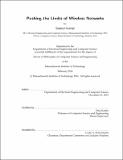| dc.contributor.advisor | Dina Katabi. | en_US |
| dc.contributor.author | Suresh Kumar, Swarun | en_US |
| dc.contributor.other | Massachusetts Institute of Technology. Department of Electrical Engineering and Computer Science. | en_US |
| dc.date.accessioned | 2016-07-18T19:11:50Z | |
| dc.date.available | 2016-07-18T19:11:50Z | |
| dc.date.copyright | 2016 | en_US |
| dc.date.issued | 2016 | en_US |
| dc.identifier.uri | http://hdl.handle.net/1721.1/103675 | |
| dc.description | Thesis: Ph. D., Massachusetts Institute of Technology, Department of Electrical Engineering and Computer Science, 2016. | en_US |
| dc.description | This electronic version was submitted by the student author. The certified thesis is available in the Institute Archives and Special Collections. | en_US |
| dc.description | Cataloged from student-submitted PDF version of thesis. | en_US |
| dc.description | Includes bibliographical references (pages 259-277). | en_US |
| dc.description.abstract | Wireless networks are everywhere around us and form a big part of our day-to-day lives. In this dissertation, we address the key challenges and opportunities of modern wireless networks. First, perhaps our biggest expectation from modern wireless networks is faster communication speeds. However, state-of-the-art Wi-Fi networks continue to struggle in crowded environments - airports and hotel lobbies. The core reason is interference - Wi-Fi access points today avoid transmitting at the same time on the same frequency, since they would otherwise interfere with each other. This thesis describes OpenRF, a novel system that enables today's Wi-Fi access points to directly combat this interference and demonstrate significantly faster data-rates for real applications. In addition, it presents MoMIMO, which demonstrates how the natural mobility of mobile users can be used to further mitigate interference. Second, can we use the ubiquitous Wi-Fi infrastructure around us to deliver new services, beyond communication? In particular, this dissertation focuses on indoor positioning, a service that has grabbed the attention of the academia and industry. While GPS has revolutionized outdoor navigation, it does not work indoors. Past work that has explored this problem is either limited in accuracy with errors of several meters, or advocates complete overhaul of the infrastructure with massive antenna-array access points that do not exist on consumer devices. Inspired by radar systems, we present Ubicarse, the first purely-software indoor positioning system for existing Wi-Fi devices that achieves tens of cm in positioning accuracy. Further, we build on this design to develop LTEye, which reveals new insights on how location impacts the performance of commercial AT&T and Verizon LTE cellular networks in the indoor space. Finally, we demonstrate how the tools we develop for indoor positioning open up new connections between wireless networking and robotics, to improve communication and security in multi-robot networks. | en_US |
| dc.description.statementofresponsibility | by Swarun Kumar. | en_US |
| dc.format.extent | 277 pages | en_US |
| dc.language.iso | eng | en_US |
| dc.publisher | Massachusetts Institute of Technology | en_US |
| dc.rights | M.I.T. theses are protected by copyright. They may be viewed from this source for any purpose, but reproduction or distribution in any format is prohibited without written permission. See provided URL for inquiries about permission. | en_US |
| dc.rights.uri | http://dspace.mit.edu/handle/1721.1/7582 | en_US |
| dc.subject | Electrical Engineering and Computer Science. | en_US |
| dc.title | Pushing the limits of wireless networks | en_US |
| dc.type | Thesis | en_US |
| dc.description.degree | Ph. D. | en_US |
| dc.contributor.department | Massachusetts Institute of Technology. Department of Electrical Engineering and Computer Science | |
| dc.identifier.oclc | 953527686 | en_US |
